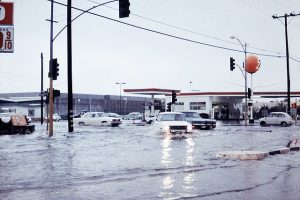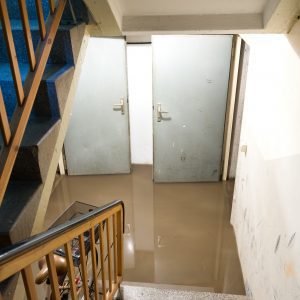Actions to Take Immediately After a Flash Flood
Massive thunderstorms are known to trigger flash floods. Even gently flowing streams can transform into torrential waters during heavy rains and leadLead is a heavy metal that can be toxic to humans, especiall... More to flash floodingFlooding is the overflow or accumulation of water in areas t... More. Essentially, flash floods are defined as rapid floodingFlooding is the overflow or accumulation of water in areas t... More that results within six hours of powerful rainstorms or other causes, like dam breaks or mudslides.
Flash floods are extremely dangerous, as the rapidly moving waters catch people off guard. People and animals can become trapped in their homes or businesses by the sudden release of high water. Because they are unexpected, flash floods pose as unavoidable threats to people who are traveling.
Rain falls on every inch of the globe, making flash floodingFlooding is the overflow or accumulation of water in areas t... More a possibility everywhere on earth. Flash floods are known to submerge busy highway underpasses as equally as isolated rural fields. City streets are hardly safe from flash floods either. Characteristically tranquil creeks can rage during flash floods.
Given the pervasive nature of flash floods, people are advised to prepare for the immediate aftermath of the devastation. Preserving the safety of people and animals is critical. Protecting property from further damage is also important.
Take the following appropriate actions after a flash flood:
1. Ensure Physical Safety
If family members or neighbors are injured, seek medical attention right away at the closest hospital. Medical clinics can thwart outbreaks of infectionInfection is the invasion and multiplication of harmful micr... More, especially in the event that contaminated floodwaters are ingested. Healthcare is necessary to address scrapes, bruises, and minor injuries that result from contact with floodwater debris.
Senior citizens, infants, and those with disabilities may require additional assistance after a flash flood. Caregivers who are in the midst of securing their own safety may need extra support. Able-bodied community members are urged to offer a hand and bring to safety those who are more vulnerable.
2. Stay Updated
Local television news channels, mobile weather alerts and radio keep the community aware of residual dangers. The risks associated with floodwaters do not subside when the waters do. Local officials will communicate when it is safe to return home or to venture into the flood-damaged areas.
3. Avoid Flood-Affected Locales
Avoid disaster areas if possible. Rescue efforts and emergency operations may be underway, and interfering serves only as an unnecessary distraction. Those who wander into damaged areas also risk exposure to the lingering effects of the flash flood, like contaminated waters, mudslides, and dilapidated roads.
Do not enter buildings that are surrounded by floodwaters. Structures engulfed by floodwaters are likely weakened due to effects of water damage, resulting in warped floors that can break upon impact, deteriorated foundations that can leadLead is a heavy metal that can be toxic to humans, especiall... More to a total collapse of the building and even sinking.
Also keep out of any property, whether it is a home or business, unless officials say it is safe to re-enter. Homes and storefronts affected by floodwaters present invisible and visible dangers. Gas leaks are a possible hazard. Electrical malfunctions can electrocute passersby if they do not heed safety warnings.
Those who must re-enter a building should shut off the electricity or consult an electrician for precautionary measures. A licensed plumber should be consulted to address damaged water lines. In the event of gas odors, immediately evacuate the premises and call the fire department.
4. Do Not Consume Water
Until officials deem it safe, avoid using tap or well water for drinking, brushing teeth, or even hand washing. These waters may be polluted with human and animal waste, chemicals, and fuels. If immediate access to safe water is critical, boil the water for one minute prior to using.
5. Throw Out Affected Food Items
Discard foods touched by floodwaters, including canned foods that are dented or otherwise damaged. Baby bottles, utensils, and bottled water should be tossed to preserve health safety. Bacteria in floodwaters can contaminate food items, resulting in severe infections when consumed.
6. Disinfect the Home
The interior of the home requires a thorough scrubbing with disinfectants. SewageSewage is wastewater containing biological and chemical cont... More water and other contaminants may have swept through the property, so be prepared to wear protective clothing, like rubber gloves, goggles, and rubber boots during the sewage cleanup process.
7. Drain the Basement
If the basement is submerged in several inches of water, make efforts to gradually drain the water. Rapid removal of water is dangerous to the overall basement structureStructure refers to the framework or components of a buildin... More. Approximately one-third of the water in the basement should be removed per day to prevent structural collapse.
8. Contact Insurance
Flood damage is rarely covered by standard homeowners’ insurance policies. Homeowners with separate flood insurance should contact their insurance representative to discuss recovery claims. Begin the claims process by documenting the water damage with photos and videos before attempting repairs.
9. Fix Damaged SewageSewage is wastewater containing biological and chemical cont... More Systems
Septic tanks, cesspools and leaching tanks should receive prompt service if they are destroyed by floodwaters. Ruined sewageSewage is wastewater containing biological and chemical cont... More systems pose as a serious health hazard. Prior to starting repairs on any part of the septic system, contact the local health department for clearance.
10. Hire Professional Help
During the wake of a natural disaster like a flash flood, many fly-by-night repairRepair is the act of fixing or restoring damaged property, m... More contractors appear, ready to take your money and run. Scammers are to be avoided, and amateur work results in costly damage. Hire only reputable and professional water damage restoration contractors for any repairs.
A professional water damage restoration service provider is dedicated to returning properties ravaged by floodwaters to a habitable condition.
Experienced technicians arrive onsite, ready to assess the extent of water damage to your property. Once the company’s recommendations and quote are accepted, technicians utilize advanced technology to thoroughly dry the structureStructure refers to the framework or components of a buildin... More. Expect powerful air movers to circulate air and dehumidifiers to rid the property of excess moisture. In the event demolition and reconstruction services are required, these professionals are fully equipped to handle the task.












